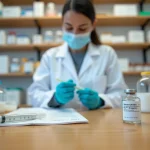Are you considering taking GLP-1 medications to manage your diabetes or obesity? It’s important to know about potential side effects and safety precautions before embarking on this journey.
This article aims to guide you through the intricacies of navigating GLP-1 medications, ensuring you have the necessary information to make informed decisions about your health.
In the first section, we will delve into understanding GLP-1 medications, shedding light on how they work and their benefits. You’ll discover the common side effects that may arise during your treatment and learn practical tips on managing them effectively.
From there, we will explore safety precautions to take when using GLP-1 medications, such as proper injection techniques and monitoring your blood sugar levels.
By the end of this article, you will feel empowered and equipped to take charge of your journey with GLP-1 medications, all while prioritizing your well-being.
Understanding GLP-1 Medications
To better understand GLP-1 medications, you should familiarize yourself with their mechanism of action and how they can help regulate blood sugar levels.
GLP-1 medications, or glucagon-like peptide-1 receptor agonists, work by mimicking the actions of a hormone called GLP-1 in the body.
The intestines release GLP-1 in response to food intake and helps regulate blood sugar levels by stimulating the release of insulin and suppressing the release of glucagon, a hormone that increases blood sugar.
By taking GLP-1 medications, you are essentially providing your body with an extra dose of GLP-1, which can help improve blood sugar control.
These medications can also slow down the rate at which food is absorbed in the stomach, leading to a feeling of fullness and reduced appetite. This can be particularly beneficial for individuals who struggle with overeating or have difficulty managing their weight.
It’s important to note that GLP-1 medications are not a standalone treatment for diabetes. They are typically used in conjunction with other diabetes medications, such as metformin or insulin, to help achieve optimal blood sugar control. Your healthcare provider will work with you to determine the best treatment plan for your specific needs.
Common Side Effects and How to Manage Them
Managing common side effects of GLP-1 medications can be made easier with proper guidance and support. It’s important to remember that everyone’s body is different, so the side effects you experience may vary.
However, there are some common side effects that you may encounter when taking GLP-1 medications. Here are a few tips on how to manage them:
- Stay hydrated: Drinking plenty of water can help alleviate some of the common side effects like dry mouth and thirst.
- Eat smaller, frequent meals: This can help with any nausea or stomach discomfort that may occur.
- Be mindful of your diet: Certain foods, especially high-fat meals, can exacerbate side effects like diarrhea. Avoiding these foods or eating them in moderation can help manage these symptoms.
- Stay active: Regular exercise can help regulate your digestion and may help reduce side effects like constipation.
- Communicate with your healthcare provider: If you’re experiencing any side effects that are significantly impacting your quality of life, it’s important to talk to your doctor. They may be able to adjust your medication or provide additional guidance.
By following these tips and seeking the guidance of your healthcare provider, you can effectively manage the common side effects of GLP-1 medications and continue on your journey to better health.
Safety Precautions for Taking GLP-1 Medications
Before starting GLP-1 medications, it’s essential to be aware that approximately 1 in 10 people may experience gastrointestinal issues while taking these medications. This can include symptoms such as nausea, vomiting, diarrhea, and stomach pain. While these side effects can be unpleasant, there are steps you can take to manage them and ensure your safety while taking GLP-1 medications.
First and foremost, it’s crucial to follow your healthcare provider’s instructions and take your medication as prescribed. Not skipping doses or adjusting the dosage without consulting your healthcare provider is smart.
Additionally, make sure to take your medication with food to help reduce the risk of experiencing gastrointestinal issues. Eating a balanced meal before taking your medication can help to minimize the likelihood of nausea or stomach discomfort.
In addition to these precautions, stay hydrated while taking GLP-1 medications. Drinking plenty of water throughout the day can help to alleviate any gastrointestinal symptoms and keep your body functioning properly.
It’s also important to be aware of any other medications you may be taking, as some medicines can interact with GLP-1 drugs and increase the risk of side effects. Always inform your healthcare provider about any other medications you are taking, including over-the-counter medications and supplements.
By being mindful of these safety precautions and following your healthcare provider’s guidance, you can navigate the potential side effects of GLP-1 medications and ensure your well-being while on this treatment.
Interactions with Other Medications and Conditions
Certain medications may interact with GLP-1 medications and affect their effectiveness or increase the risk of side effects. Additionally, some health conditions may require special precautions or adjustments in the use of GLP-1 medications.
For example, certain antibiotics, such as sulfa drugs, may interact with GLP-1 medications and lead to low blood sugar levels. It’s essential to inform your healthcare provider if you’re prescribed any antibiotics while taking GLP-1 medications, so they can monitor your blood sugar levels closely and make any necessary adjustments to your treatment plan.
Other medications, such as corticosteroids or diuretics, may also interact with GLP-1 medications and require careful monitoring.
In addition to medications, certain health conditions may also require special precautions when taking GLP-1 medications. For example, if you have a history of pancreatitis or gallbladder problems, your healthcare provider may need to consider alternative treatment options or closely monitor your condition while you’re on GLP-1 medications.
Monitoring and Reporting Adverse Reactions
Keep an eye out for any adverse reactions and promptly report them for monitoring purposes. When taking GLP-1 medications, you must be aware of any changes in your body and communicate them to your healthcare provider.
Here are four things you should do to monitor and report adverse reactions effectively:
- Pay attention to your body: Take note of any unusual symptoms or side effects you may experience while taking GLP-1 medications. These can include nausea, vomiting, diarrhea, or stomach pain. Be aware of any changes in your blood sugar levels as well. By being mindful of your body’s responses, you can provide valuable information to your healthcare provider.
- Keep a journal: Maintaining a record of your symptoms and any changes you observe can be helpful for both you and your healthcare provider. Note down the date, time, and severity of any adverse reactions you experience. This will provide a detailed overview of your symptoms and help your healthcare provider better understand your situation.
- Contact your healthcare provider: If you experience any adverse reactions, don’t hesitate to reach out to your healthcare provider. They’re there to support you and can guide you on managing any side effects or adjusting your medication if necessary. Promptly reporting any adverse reactions will ensure that you receive the appropriate care and monitoring.
- Follow up with your healthcare provider: Follow up with your healthcare provider as advised after reporting any adverse reactions. They may want to conduct further tests or adjust your medication regimen to ensure your safety and well-being. By actively participating in the monitoring process, you’re taking an essential step towards managing your health effectively.
Frequently Asked Questions
Can GLP-1 medications be used during pregnancy or while breastfeeding?
Sorry, but GLP-1 meds like liraglutide and exenatide aren’t recommended during pregnancy or breastfeeding. They could potentially harm the baby. It’s best to talk to your doctor about safer alternatives. Take care!
Are GLP-1 medications suitable for individuals with a history of pancreatitis?
Yes, GLP-1 medications may not be suitable for individuals with a history of pancreatitis. Consult with your healthcare provider to find alternative options that are safe for you.
What should I do if I accidentally miss a dose of my GLP-1 medication?
If you accidentally miss a dose of your GLP-1 medication, don’t panic! Just take it as soon as you remember, unless it’s almost time for your next dose. Remember, better late than never!
Can GLP-1 medications cause weight gain or weight loss?
Glp-1 medications can actually help with weight loss by reducing appetite and increasing feelings of fullness. They are not known to cause weight gain. Stick to your prescribed dosage and follow a healthy lifestyle for the best results.
Are GLP-1 medications safe for individuals with kidney problems?
Are GLP-1 medications safe for individuals with kidney problems? Absolutely! They not only help manage blood sugar levels, but also be safe and effective even for those with kidney issues.

















